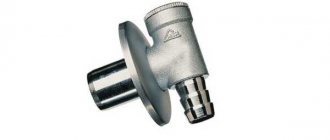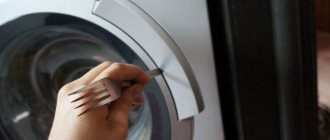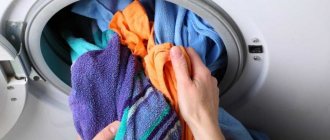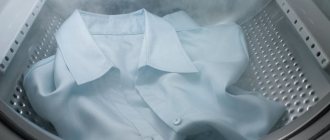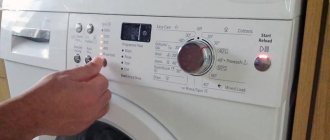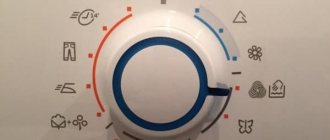Modern household appliances are equipped with a large number of programs and additional functionality. Proper use of the washing machine's capabilities allows you to keep your clothes clean and fresh. To combat complex stains, the designers added a pre-wash option.
- What is the “pre-wash” mode in SMA
- How to use this option
- Nuances by brand
- Recommendations for use
- Catalog of washing machines with characteristics
Washing technology in SMA
Simply rinsing your laundry in water will not make it cleaner. Washing is a technological process that includes:
- Stages. The laundry needs to be soaked. Leave it in the water for a while, adding detergent to it. Before the advent of washing machines, not a single serious wash could be done without soaking. While dirty items lie in water with powder or soap, the fabric fibers soften - this allows detergent particles to penetrate into the spaces between them and more actively dissolve grease and dust contaminants. In SMA, the process has changed, but its goal is the same - to prepare soiled laundry for the main stage. The soaking function in the washing machine is reduced to a mode that involves slowly rotating items in lukewarm water.
- Conditions. The amount of water, the ratio of water and laundry, and the temperature change. In washing machines, the rotation speed of the drum is set - it is measured in revolutions per minute. The temperature is set according to the selected program, and the user loads the drum based on the manufacturer’s recommendations. In certain modes, the drum is loaded at 50% or less.
- Facilities. Depending on the type of fabric and the degree of contamination, a detergent is selected - a regular powder for SMA, with bio-enzymes, or a gel-like product.
Subtleties of use
All information about the modes can be found in the instructions for the machine. There are certain subtleties in using each.
Here's what it says about prewash:
- It is carried out only with dry powder. If you open the instructions for using the automatic machine, you will find information that the main compartment cannot be filled with gel while this function is turned on. The fact is that the liquid product smoothly slides down the tube. When it comes to the main cycle, the compartment is already empty.
- The function is not compatible with express modes. If it doesn't want to turn on, then most likely you chose an express wash. The manufacturers decided that it was not needed here. It is logical that if you need to wash things quickly, it means that the laundry is not so dirty and does not require pre-washing.
- Manufacturers prohibit pouring anything other than washing powder into the pre-wash compartment.
We recommend: How to properly wash an elastic bandage - can this be done in a washing machine?
When to turn it on?
How do you know when you can't do without pre-washing? If things are heavily soiled, persistent, numerous, or old, you are unlikely to get by with a regular program. The mode can be launched before all the main programs - “Cotton”, “Jeans”, “Synthetics”, “Dark items”. Turn it on before gentle, manual and intensive mode. Pre-washing is a delicate process; it will not harm even the most capricious fabrics.
Today, many people wash their clothes almost every day - why save up dirty laundry if there is a machine that can quickly freshen up any item. For this purpose, express mode is launched. No soaking is required before fast programs.
When and how to use prewash
Having understood what prewash is, you should know when to use this function. This mode is intended for washing heavily soiled laundry. It helps to avoid the soaking procedure and promotes high-quality washing of heavily soiled items. For detergents, you can use the same powder as for the main wash cycle.
In terms of duration, the pre-wash procedure does not take much time; on average, it can increase the process by 16-20 minutes. This mode is activated in some models by turning the toggle switch or by pressing the corresponding button in other washing machines. To set the pre-wash mode correctly, you need to familiarize yourself with the list of functions. Often on the panel of the washing machine there are numbers that correspond to a certain mode depending on the type of fabric.
It should be remembered that the pre-wash option is not provided for all fabrics; it can be used for items made from synthetic cotton or denim. Acceptable modes:
- "Eco" or "Children's things";
- “Stain removal” or “Dark things”;
- “Daily” or “Intensive wash”.
Upon closer inspection, the extra wash function is indicated by a specific icon on the display.
Algorithm of actions
If there are useless or unnecessary modes or programs in some washing machine models, it is definitely not pre-washing - it is just as important as rinsing or spinning. What the user must do:
- Before turning on the SMA, fill the powder compartment. An additional portion is poured into the second compartment - it is located in the container marked with the number “I”.
- Press the corresponding button on the control panel.
After this, the machine starts working. What's going on in it? Algorithm:
- The machine fills the tank with a lot of water. The heating element heats it up to 30 °C.
- Water is collected, powder is consumed from tray “I”, and remains in tray “II”.
- The drum rotates slowly - the powder gradually dissolves, and the laundry is washed. How long does the process take? The exact time depends on the model and manufacturer of the SMA, on average - two hours.
- The machine drains dirty water and fills it with clean water.
- The drum begins to rotate fully. The powder from the second tray is consumed. Then the program that the user selects is launched - “Cotton”, “Synthetics” or any other.
- Then - rinse, spin. You can run an additional rinse.
Secrets of washing modes
So, let's look at the points.
Cotton/linen mode
Peculiarities:
- High temperature (about 90 degrees)
- High spin speed (more than 1000 rpm)
The “hottest” washing modes are “Cotton/linen” or those aimed at children’s underwear with boiling (90-95 degrees). However, in most washing machines, these are the modes used to wash fairly heavily soiled items of clothing and linen (for example, men's shirts, T-shirts, as well as towels and bedding). It should be noted that it is in modes aimed at washing natural fabrics that multiple rinses are used, as well as spinning at high speeds. This is due to the fact that the powder is quite difficult to rinse out of them, and the fabrics themselves are very hygroscopic.
One of the popular models of washing machines, distinguished by its richness of washing programs, is Eurosoba 1100 Sprint Plus . There are not only all the “default” programs, but also special modes - for example, for jeans, down and sports items. In addition, there is a bioenzyme phase that allows you to actively use enzyme detergents when washing, which perfectly remove any protein stains, such as blood stains, chocolate stains, etc.
Synthetic mode
Peculiarities:
- Low temperature (about 40 degrees)
- Low spin speed (no more than 800 rpm)
“Mixed fabrics” or “Synthetics” mode makes it possible to wash different fabrics in one wash, and usually washing occurs at a low temperature - 30-40 degrees. You can manually increase it to 60, but this is not always useful, since some types of synthetic fabrics can become deformed at 60 degrees. If you cannot figure out which mode to use when washing a particular item, be sure to use the instructions on the label, which is usually sewn into one of the internal seams - at least you won’t be mistaken with the temperature.
Wool mode
Peculiarities:
- Low temperature (up to 40 degrees)
- Low spin speed (no more than 800 rpm)
- Special drum rotation algorithm
"Wool" mode is no secret. However, two points must be kept in mind: firstly, this mode should be used not only for washing purely woolen products, but also those made from any yarn that uses even a small percentage of wool (which, by the way, can be hidden in the label under the name “mohair” "or "alpaca"), and in addition, it is necessary to have a special detergent on hand for washing woolen and delicate fabrics, which will soften the product and at least slightly protect it from wear and tear during intensive spinning. By the way, the speed of the latter in this type of washing is very low - no more than 800.
Almost an analogue of this type of washing is the “Delicate” or “Gentle Wash” mode. Manufacturers of some machines call it “manual”. In this mode you can also wash wool, delicate linens, as well as silk blouses, stoles and ties. In this case, washing occurs at low temperature, and the spin speed does not exceed 400 revolutions. In addition, it is also preferable to use special detergents here.
Some machines have different options for washing only black or only white laundry, and sometimes these modes are combined, for example, “Black / white 40” . This means that in this mode you can wash both black and white clothes - at a temperature of 40 degrees.
An inexpensive but multifunctional option for a washing machine is the Hotpoint-Ariston RST 601 W , which also allows you to wash any item - from a down jacket to a baby bib - and at the same time fully comply with the manufacturer’s washing requirements.
In conclusion, it should be noted that there are general washing rules. If you follow them, you will not damage your items or your washing machine.
Quick wash mode
Peculiarities:
- Low temperature (30-40 degrees)
- Cycle time - no more than 40 minutes
Things don’t always need a full wash: for example, underwear or even shirts can simply be “refreshed.” In this case, it is quite possible to use the “quick wash” mode: in it the water is heated to a maximum of 40 degrees, the time of standard procedures is reduced, but in general the entire cycle of operations is complete.
“Baby underwear” mode
Peculiarities:
- High temperature (90 degrees)
- Rinse thoroughly
- Maximum spin speed
What is important when washing baby clothes? Firstly, wash off stains and ensure that dust mites are destroyed (if there are any) - so the washing temperature in this mode is quite high. Secondly, carefully remove the powder - that's why an additional rinse is used. And thirdly, drying clothes quickly is the reason for using maximum spin speed.
An important point: not all children's clothes can be washed in the "children's" mode . For example, synthetics cannot be washed at 90 degrees.
If you really have to wash a lot of baby cotton clothes, choose a machine with a high spin speed. For example, this Candy GVS4 136TWB3/2 drum can rotate at speeds of up to 1300 rpm.
Manual mode
Peculiarities:
- Special drum rotation algorithm
- Minimum spin speed
In the “manual” mode, they wash things that cannot withstand traditional washing in an automatic machine. Therefore, the main task is to be extremely sensitive to the contents of the drum. As a result, the program does not allow high speeds during washing and spinning, and the laundry does not deteriorate. But it’s unlikely that stains can be removed in this mode.
Even inexpensive machines have manual or delicate modes - for example, this Indesit IWUC 4105.
Control panel icons
To find out what a particular icon on the control panel means, you can look at the instructions. Manufacturers often write the name of the mode - then no questions arise.
Most models have the same icon indicating pre-washing - W-shaped. This is the icon used in models from Samsung, LG, and Bosch.
Does she always help?
If things are covered with stains that are difficult to remove, then even “soaking” in SMA will not help remove them. Often the users themselves are to blame for this. How to avoid problems:
- Do not stack laundry with different levels of soiling together. Dirtier products will stain the “neighbors.” Colored laundry may fade due to close contact and high humidity.
- Do your laundry weekly—don't hoard dirty laundry.
- Treat items with stains. Remove dirt. If this is not done, then the stains after contact with heated water will become even stronger in the fabric fibers.




